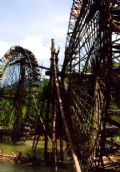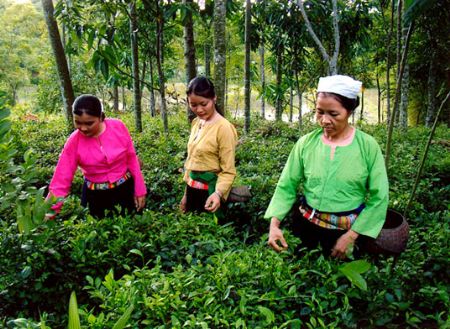|
|

The Muong ethnic
people’s calendar used
for calculating
production
cycles.

A large bamboo
basket
for catching fishes.

The trap, an effective
tool for
hunting.nbsp;
nbsp;nbsp;

Casting net on the
Buoi River in Muong Vang.

Nai, a tool for
harvesting rice.nbsp;nbsp;

Wheels to carry
water
from streams to terraced rice fields.
| About 70km
northwest of Hanoi is the prosperous region of the Muong people. Together
with Hoa Binh town, the four surrounding areas of Muong Vang, Muong Bi,
Muong Thang and Muong Dong are described as the cradle of the Red River
civilization. Living in the valleys along major streams, the Muong people
engage in wet-rice farming and hunting.nbsp;
Hunting tools
Hunting has, since the
ancient time, become a main economic activity of the Muong people who used
materials largely from nature like bamboo, wood and rock to make their
hunting tools. On the land, traps have been mainly used, even after the
introduction of firearms like flint-locks. Traps are made from rock slabs
with bait placed on the triggers. When animals step on the triggers, the
traps snap closed and the heavy rock slabs kill the animals. The traps can
also be made from iron or bamboo, and placed on trails, which hold the
preys through the elasticity of the bamboo planks and iron spirals. Nets
can also be made into traps suitable to hunting at night.nbsp; They are
set on the sides of trails at twilight by hunters who then hide
nearby.nbsp; As animals move along the trails, the hunters begin making a
lot of noise causing the animals to leave the trails, and run into the
traps.
Cross-bows are the most ancient
hunting tools used by the Muong people for small animals and birds. Unlike
the noisy flint-locks that scare away animals, cross-bows are quiet and
allow hunters to return to the same productive area many times.
nbsp;Living along rivers and
streams, the Muong have developed effective fishing tools and techniques.
Centuries ago, they learned to make fishing nets from tree barks. Tens of
rafts form a circle and the nets are simultaneously thrown into the water
to the cheer of hundreds of villagers. The Muong people do not eat fish
eggs, so the pregnant fishes are released while the remainder is equally
divided among the households. Fishing this way happens only once or twice
a year and brings a festive atmosphere to the Muong villages. Another
fishing method is to place large bamboo baskets with “one way” lids into
flowing streams, allowing fish to enter but not escape.
Now that the forest coverage
has shrunk and cultural and economic exchanges have been boosted, hunting
activities have become scarce and their economic significance has almost
vanished. In many localities, young Muong do not know their ancestors'
hunting methods.
Water wheels
The Muong people often build
their on-stilt houses leaning against mountains and facing streams.
Wet-rice farming tops their production activities, and rice is taken as
the main food in their diet. Small ploughs and harrows are their common
soil preparation tools. Ears of rice are harvested from fields, dried and
kept at home. When food is needed, those rice ears would be thrashed and
husked. In their wet-rice farming, the Muong people boast a unique form of
irrigation: they use large waterwheels to carry water from streams to
terraced rice fields. A water-wheel system includes a dam and a wheel. The
dam is made from bamboo stakes driven firmly into the bed of a stream in
arc form. The dam is about 1 meter high above the water surface and made
of baited “guot” (a kind of strong grass). The dam does not
block the flow completely but directs it to the wheel, which measures
about 5m-10m in diameter. The wheel’snbsp;nbsp;axle is made of
“doi” wood which is firm but soft and long wearing, and its spokes
made of hard bamboo sticks. The wheel rim is about 1m in diameter and made
of various bamboo wattles. Large bamboo internodes are placed at an angle
of 45 degrees from the rotary moment to bring water to fields up to 8
metres higher than the water surface.

The Muong people often carry “op” by their side when
going out.
| “Op” - basket or purse
“Op” is a multi-purpose basket often
wore by the Muong people by their side. It is hard to tell whether it is a
purse or a basket as it is part of their costumes, which helps easily
determine the class, the sex and the age group of its owner. The large
“op” is carried by an adult while the small one, by children. The
square “op” is used by males while round one by females. The thin
“op” tells us the carrier is a commoner while the thick one
indicates its carrier is an aristocrat. However, the “op” can be
described as a basket as it is used to keep anything the Muong may pickup
during their daily activities. In many cases, the “op” can be used
as a wedding offering: the bride is expected to bring a pair of large
“op” to her groom's family.
Story: Nguyen Tuan
Longnbsp; -nbsp;Photos: Dinh Cong
Hoan
|